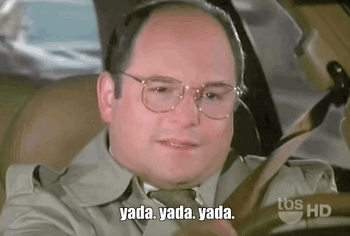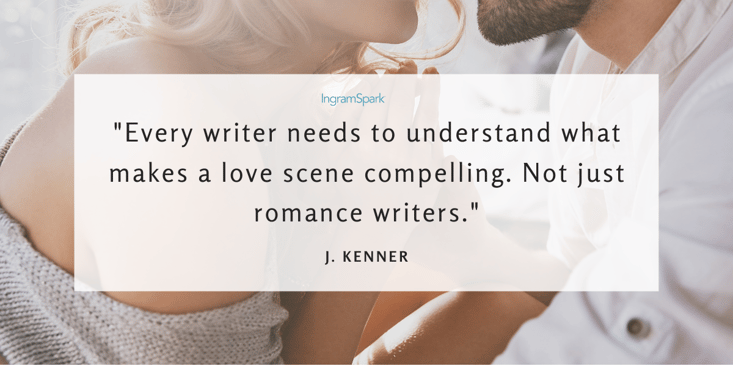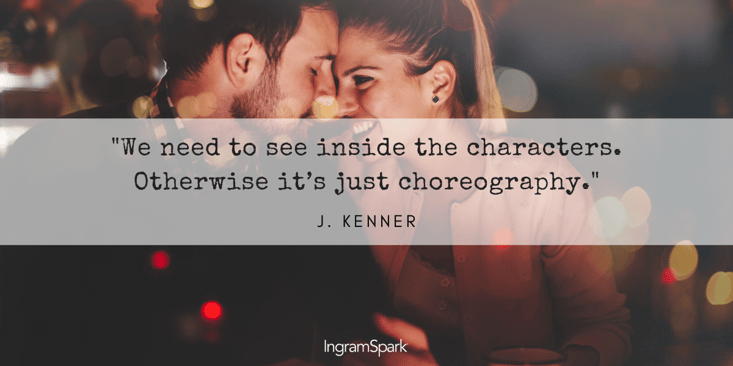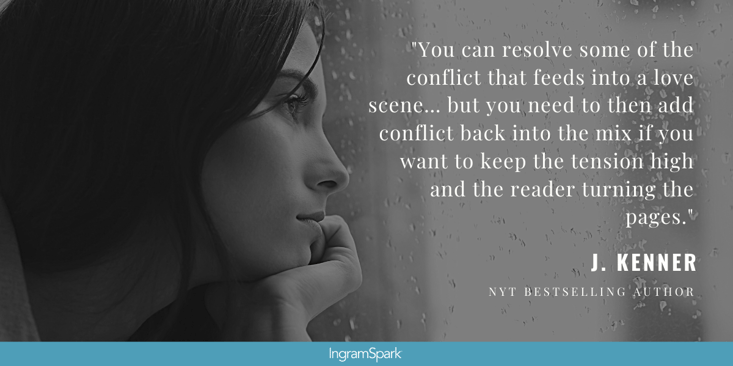Emotionally driven love scenes can be a powerful part of any story in any genre. And in a romance novel, they are even more key, because the love scenes can and should inform the arcs of both the characters and their relationship, letting readers understand more deeply both what is pulling these characters close… and also what is keeping them apart. So how do you accomplish that?
Many years ago, I drove across the country with my husband, and during the trip we listened to several audiobooks. One of them was a spy thriller—a genre we enjoy. There was action. Adventure. An alpha spy doing his super-spy thing. And a love interest (or, at least, a sex interest).
There was banter. There were sparks. And the goal in the story was for the reader to believe that this hero really cared about this woman.
Why?
Because the bad guys eventually kill the woman, thus sparking the hero to go off and "Do His Spy Thing" with even more intensity. Because he’s pissed, right?
Of course he is… but it would have been so much more effective for the story if the sex scene hadn’t been a sex scene.
It needed to be a love scene.
We needed to feel the connection between those characters, and we didn’t. The hero might as well have been sleeping with a plastic doll for all the emotion he seemed to feel for her. And that meant that the ultimate climax of the book—that drive to avenge her—fell flat.
I say all of this not to dis the writer, but to make a couple of points. First of all, every writer needs to understand what makes a love scene compelling. Not just romance writers. Second, Tab A/Slot B sex is boring (and often, so bad that it’s funny and makes the rounds on Twitter).
Are you ready to learn how to create emotionally driven love scenes? Let's dive in.
Emotionally Compelling Love Scenes Are All About the Characters
Love scenes are all about the characters... not just the sex.
Seriously. In writing a love scene, you have to worry less about choreography and more about characters—both in and out of the bedroom. Because how can it be an emotional experience for the reader if a) the characters themselves aren’t feeling those emotions, and b) the writer isn’t putting that emotion on the page?
That means making sure that there is a connection between the characters before they even get to the bedroom. And please note that this is just as true for bad sex. An assault. An awkward hook-up with an ex. What matters is what comes before the scene informs the scene.
I talked about this recently with New York Times bestselling author Tracy Wolff (heads up: her newest book Crave will be released in April 2020!) and she put it beautifully:
“Writing an emotionally compelling love scene is all about the connection between your characters. Whether it is a kiss in a young adult novel or a highly explicit erotic scene, there needs to be an emotional payoff for the reader. And that payoff only happens when you’ve stoked the flames between your characters—not just sexual tension, though that is hugely important, but also the emotional connection between the characters as well as the high stakes that should be keeping them apart.”
New York Times bestselling author Carly Phillips agrees.
“A compelling love scene, even a one night stand, has to have an emotional component in order to snag a reader’s interest and get them invested.”
All of which is well and good, but how do you do that?
Honestly, it’s a lot like acting. Only you’re not just acting one role; you’re everybody.
You, as the author, must find a way to “break” your characters. To get into their head and convey their unique way of looking at the world to your audience, the reader.
Sounds a bit overwhelming, but it’s the best part of writing. You have to truly know your characters to feel confident in where the story is going—because then the characters are making the choices, not you as a puppet master.
To do that, you want to dig deep and use your own experiences to inform the choices and emotions of your characters.
Your experiences probably won’t align directly with what your character is going through, but you can find an emotional nugget that you can build from.
So much of sexual tension is awareness, physical and emotional. A slow burn, if you will, where the characters notice and react to each other on all levels.
So how do you relate to that? Maybe you could think about your first crush in high school. How every little movement meant something, and if she/he/they happened to catch your eye across the room, it could send your heart pounding wildly for hours.
The best love scenes tap into core emotions, so that there’s just as much heat being generated before any consummation, and, when you finally get to the love scene, the reader is just as desperate as the characters are.
Increasing Conflict to Build Tension
Phillip's book Dare Me Tonight illustrates this well. In that book, the heroine is younger than the hero and from a dysfunctional family. The man she’s chosen to sleep with for her very first time at twenty-four is in business with the heroine’s brother, and so the two must keep their night together a secret.
Notice how the heroine’s emotional state—desire mixed with trepidation at her first time, longing for the hero, frustration at the secret they must keep—all play into not only keeping the heat level up but in keeping the reader interested.
Even more than that, though, this scene—like every scene in a book should—moves the story along. In this case, by increasing the conflict.
That push/pull between what she wants and what she ultimately can’t have. She wants a hero. The right man. But considering the parameters they’ve set, how can this man be the right one?
Excerpt:
"She hadn’t been prepared for such intensity, though she should have been. Everything about Ethan Knight was potent. Tonight had the power to change her world except, as he’d reminded her, it was one night.
A night never to be shared with anyone. She’d ignored the dagger she’d experienced at being relegated to his dirty secret, telling herself she understood. Sometimes there were reasons for discretion, and with everything at stake for him with the Miami Thunder Stadium, his request made perfect sense.
Even if it dug at the very pieces of her heart that she’d glued together over the years."
Internal Monologue vs. External Dialogue
Here’s another wonderful illustration from Wolff’s book, Ruined, which features two damaged characters who find it nearly impossible to trust.
"My body lights up like New Years, my fear mingling with his fury, my arousal tangling with his need. And I know—I know—that there’s no more reason to fight it. Because this is Ethan. He might have torn my heart to pieces, but he still holds me like I’m the most precious thing in his world."
These scenes work so well because at this point we already know the characters. But even so, both authors remind us of the core issues for the heroines. Not because the author tells us, but because the heroine does.
Join IngramSpark's 30-Day Writing Challenge for Daily Writing Tips and Motivation!
But please don’t think that I’m saying that you can’t write an emotionally compelling love scene in chapter one or as a one-night stand five minutes after the characters meet. Of course you can. But I am saying that you still have to set up those characters so we know what is at stake for them and why they are diving in like that. We need to see inside the characters. Otherwise, it’s just choreography.
As you probably noticed, in the examples above, the heroine is “talking” to us through her internal monologue. But actual conversation can also go a long way to informing the connection between the characters.
As bestselling author Darcy Burke says,
“I write Regency historical romances and often the heroine has either none or very little sexual experience. The first time (and even after) they are together, conversation between them can be both informative and arousing, and it absolutely builds the relationship between the characters.”
Check out this excerpt from Burke’s A Duke Is Never Enough, which illustrates how the dialogue can strengthen the relationship and add heat to the scene.
He kissed her cheek, her jaw, her ear. “Tell me what you feel.”
“I can’t explain it.” Her words were breathless. “Where you’re touching me... It’s like starting a fire. The flames are there, but I need it to catch.”
He grinned. “Let’s see if I can stoke it.”
Creating a Connection Between Characters
So we need the connection... how do we build it?
Great question, and again, it comes down to knowing your characters. But there are also some techniques that you can use to help reveal in an external way what is going on with your characters internally.
It probably goes without saying, but I’ll say it anyway.
You need to start with attraction.
Even in an enemies-to-lovers story, there’s attraction. Maybe it’s physical. Maybe it’s even borne of revenge, but something is pulling these two people together. We’re talking attraction like in your old high school science class—something in those characters that speaks to the other and pulls them together.
And that’s about characteristics that your characters find attractive on the deepest level. That doesn’t mean drooling about six-pack abs or going ga-ga for a woman in a tight skirt.
Maybe it’s his smile—it’s tender and sweet with just a hint of amusement. Or the way she looks at everyone so directly, without ever flinching.
Maybe they’re in a convenience store and she’s in a battle with the clerk. She feels like nobody at all is on her side, when this sweaty runner she wouldn’t normally have noticed steps in to solve the conundrum, and she sees a goodness at the core of him.
Maybe he’s her business nemesis, but even though he’s the bane of her existence, he’s competent and fierce and exudes all those qualities. A warrior at his core. Not what she told herself she wanted, but you can’t hide from your ultimate desire.
So there will be awareness at that first meet, but that level of awareness is going to change as the story grows, just like it changes in any relationship—and you as the writer need to show those changes through the emotional reactions and also the physical interaction between the characters.
So how do you do that? Well, you have to get close enough to the characters to see what they see and to feel what they feel. Like I said above, it’s like acting. But here’s where I tell you about those techniques I mentioned.
Showing a Connection Between Characters
1. Go deep into the character’s thoughts.
2. Show their reactions—physical and verbal.
3. Physical description—but use sensual words as much as possible (more about this later).
4. Think about the proximity of the characters in relation to their level of intimacy.
Desmond Morris, author of The Naked Ape, sets out these stages of intimacy:
- awareness of presence
- eye to eye
- verbal
- hand to hand
- arm to shoulder
- arm to waist
- mouth to mouth
- hand to head
- hand to body
- etc...
As a general rule, most people internalize these stages and don’t plan these steps when they write because they are in character. But if something feels off, go back and see if you skipped a step or re-ordered them. You might find that following the path increases the intensity of your scene.
5. Use all the senses.
Remember, sensuality comes from your senses. Practically… and linguistically!
- Sight: what they see, what that sight evokes, how they react. Pay attention to the words used to describe it. Not just red lips and tan skin. But lips that made him think of strawberries and sun-kissed skin that he imagined had absolutely no tan lines.
- Taste: the food, his skin, etc.
- Sounds: music, wind, the melody of voices, of words
- Touch: the feel of his skin touching her (and the reaction!!)
- Smell: perfume, food (remember, scents can enhance eroticism)
Here’s an example from my novel, Release Me, that illustrates a few of the points above.
This is a few moments after they’ve met; by this time, she’s already described him physically to the reader:
He takes a step back and with slow deliberation (establishes his confidence and personality) looks me up and down. His inspection seems to last for hours, though it must take only seconds. The air between us crackles, and I want to move toward him, to close the gap between us again. (awareness of presence)
But I stay rooted to the spot. (reaction, informs her character) He lingers for a moment on my lips before finally lifting his head to meet my eyes, and that is when I move. (eye to eye)
I can’t help it. I’m drawn in by the force and pressure of the tempest building in those damnable eyes. (reaction)
Choosing the Location of a Romance Scene
Be deliberate about the locations of your scenes. The surroundings can inform a budding love scene almost as much as a caress can.
For example, the setting can magnify a theme or a character trait. In this excerpt from Wanted, the heroine feels stifled. She wants to “fly” out into the world. She wants to let go. In this scene, the hero finds her while she’s looking out a skyscraper window. At this point, there is nothing between them but an intense attraction they are both fighting, because he’s promised her uncle that he would stay far away from her. The scene illustrates their attraction and also subtly reveals just how much the hero understands her. And how much she wants to surrender to him. To fly.
Excerpt:
“It’s not a weakness to want to let go,” he said. “To want the thrill of taking a risk. The pleasure of feeling the rush.”
I blinked. “How did you—”
“Shhhh.” His smile was slow and easy, revealing a rarely seen dimple in his cheek. “You need it. You’ve been pent up all night, going crazy. Locked inside your grief. Go ahead, now. Close your eyes and turn around.”
“But, I—”
That finger rose and pressed gently to my lips. “Don’t argue. Just do.”
Unquestioning obedience isn’t usually my modus operandi, but to my surprise, I complied. I closed my eyes, letting the dark take me, and then I shifted, so that I was facing the glass again. If I had opened my eyes, I would have seen the night sky spread wide in front of me. Instead I saw only Evan, larger than life inside my head.
The setting can also highlight through contrast (a hot kiss in a smelly alley; a romantic ride in a Ferris Wheel on a freezing night when she forgot a sweater). It can even provide a catalyst for a character’s reflection.
Creating Connection... But Also Conflict
Did you notice how in most examples, there is conflict?
Conflict between the characters or internal conflict, where a character is essentially at battle with themselves. That is because conflict is another key component of a compelling love scene.
Because unless your story is over, there is still something keeping these two people apart.
And it’s going to be revealed through intimacy. Conflict can feed sexual attraction—the characters are pulling apart even while chemistry/attraction is pulling them together.
Conflict also allows us to sustain the sexual tension even after the characters have made love (or come pretty dang close). So if you’re not writing a very sweet romance where the only love scene is the culmination of the book, you can continue to have that tension between the characters even after they’ve made love.
Start with the conflict that is keeping the characters apart—in Release Me, the heroine, Nikki, is a cutter. Initially, she doesn’t want Damien to see her scars, and yet she is very into the seduction. So there is an internal push/pull going on with her, but ultimately, the fact that she is damaged wins out… until it doesn’t.
Later, it is his understanding and acceptance that makes the love scene that much sweeter.
But that’s not the end of the book; not even close… so we need more conflict and the story shifts.
Now it turns on Damien’s conflict.
In other words, you can resolve some of the conflicts that feeds into a love scene… but you need to then add conflict back into the mix if you want to keep the tension high and the reader turning the pages—and you do want that!
Focusing on the sensuality of your language even outside of a sex scene also increases the heat and sexual tension, and paves the way for an even more compelling love scene.
Why? Because your book is part of a relationship with your readers. You want to tease them as much as you want the characters to tease each other. It’s a bit like foreplay with the readers before you get to the actual love scene.
So think about the words you are using. Are they evocative? Pretty words that caress the senses or harsher words that talk about the characters?
As much as possible, they should be... but not in a way that makes your prose seem pretentious or a close relation to a thesaurus. You don’t want to sound like an overbearing catalog of adjectives. And the way to do THAT is to tie it to the characters.
Putting the Pieces Together in a Love Scene
I said above that love scenes aren’t just about the choreography between the characters. In fact, one of the hottest, most emotionally revealing scenes I’ve written is the character’s first sexual encounter in Release Me… and the hero isn’t even there. He’s on the other end of a phone line as she’s in a limo. And not only is the scene scorching, but it reveals so much character about the hero and the heroine.
And the only reason that scene works is because there has been so much push and pull between the hero and the heroine in the first couple of chapters of the book.
My limo example is part of why I’m confident in saying that Tab A/Slot B choreography is very low on the list of what makes a scene emotionally compelling. Ultimately, you want to make sure all the various body parts are where they are supposed to be and no one has an extra arm, but before you get there, you need to make sure that the deeper elements of the love scene are addressed.
- Dialogue: how much are these characters willing to share with each other at this point in the story, and how comfortable are they communicating?
- Internal reactions: what are they each feeling about making love and how is that changing their perception of their world and their partner?
- Physical reactions: these can be more detailed depending on what type of story you’re writing (more detailed more steam). The point is to show how comfortable (or not) the characters are with each other and how they react to their lover’s touch, to keep the reader from getting lost in the staging.
Writing a Love Scene: Getting it On Paper
So we’ve gone over the components. How do you actually get it on paper? That’s a more tricky question than it seems. The obvious answer is that you write it, but it's not quite that simple.
Physically or emotionally intense scenes (action scenes, fight scenes, love scenes) can be exhausting to write.
If you’re working to make the scene as intense and rich as possible, it can be much more draining than other elements of writing a book.
When I first started writing, I had to go straight through, editing as I went, from word one to the very last bit of punctuation. Every day, I would read what came before and edit it. So that by the time I finished the book, it was pretty much ready to go off to my editor.
Now, I still tend to write that way… with one exception. Love scenes.
Early in my career, I discovered that I would end up spending an entire day on a love scene to the detriment of moving the story forward. But now I find that the “pushing through” process just doesn’t work for me.
 What I do instead is “yada yada” the sex. For those of you who haven’t seen that particular Seinfeld episode, what I do is hit the high notes of the scene, then move on. I’ll add in shorthand notes to myself about the emotional beats and physical choreography so that I will remember what was in my mind when I come back. But I’ll move through. Very rough. Very unpolished. Very minimal.
What I do instead is “yada yada” the sex. For those of you who haven’t seen that particular Seinfeld episode, what I do is hit the high notes of the scene, then move on. I’ll add in shorthand notes to myself about the emotional beats and physical choreography so that I will remember what was in my mind when I come back. But I’ll move through. Very rough. Very unpolished. Very minimal.
The next day, I’ll come back and edit it, layering in more as I go. And as I do, I think about the characters’ needs and motivations. I think about conflict. I think about the setting. I think about my word choice. And, yes, I think about choreography. And the scene grows.
And the next day I repeat the process, adding text and cleaning up previous words. And the scene gets even better.
Sometimes, I’ll end up flying through the scene on day two. But usually, it takes several passes. Either way, ultimately the scene is richer for the process. It’s a bit like blocking a play, then adding in the actor’s small nuances and character interpretations.
Then, when I type "The End", I have a compelling love scene that is emotionally rich and moves the story along. Obviously, not everyone’s process is the same, but if you’re still looking for how you can make your love scenes more emotionally rich and satisfying, I hope you’ve found something in this article that is of use to you!



.png?width=733&name=Copy%20of%20Romance%20Blog%20Post%20Quotes%20(5).png)













